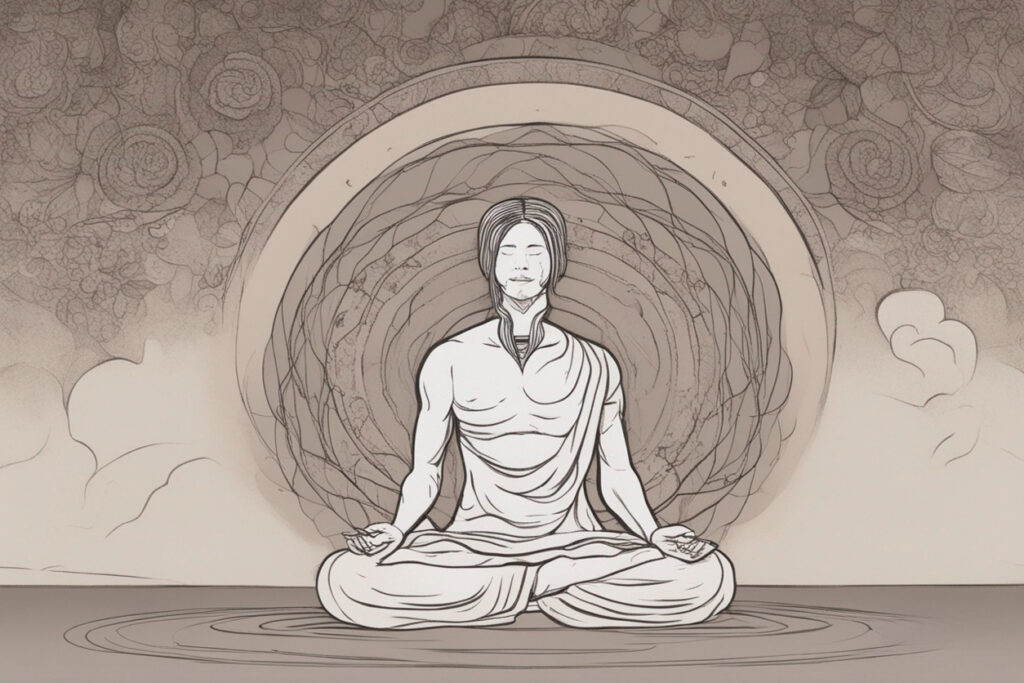Table of Contents
Welcome to your guide to effective guided meditation! Whether you’re new to meditation or a seasoned pro, this article will provide you with the tools and techniques to enhance your practice. Guided meditation can help you find inner peace, reduce stress, and improve your overall well-being.
It’s important to find the right guided meditation techniques that work for you. Everyone’s practice is unique, so it’s essential to explore different techniques and find what resonates with you. This article will explore various techniques and provide instructions on how to incorporate them into your daily life.
Key Takeaways:
- Effective guided meditation can improve your overall well-being and reduce stress.
- It’s essential to find the right guided meditation techniques that work for you.
- Exploring different techniques and seeking reputable sources can enhance your practice.
Understanding the Benefits of Guided Meditation
Are you seeking a way to relax and reduce stress? Guided meditation may be just what you need to help you achieve inner peace and improve your overall well-being. Here are some of the benefits of guided meditation:
- Relaxation Techniques: Guided meditation can help you learn relaxation techniques to calm your mind and body. Through deep breathing and relaxation exercises, you can release tension and improve your sleep quality.
- Stress Reduction Techniques: Daily stress can take a toll on your physical and mental health. Guided meditation can help you cope with stress by giving you tools to stay calm and centered in the face of adversity.
By incorporating guided meditation into your daily routine, you may find that you are better equipped to handle challenges and enjoy a more peaceful state of mind.
Exploring Different Guided Meditation Techniques
Guided meditation can help you find inner peace, reduce stress, and improve your overall well-being. There are different techniques you can try to enhance your practice and make the most of your meditation sessions.
Mindfulness Practices
Mindfulness is a popular form of guided meditation that involves focusing on the present moment, acknowledging your thoughts and feelings, and accepting them without judgment. Mindfulness practices can help you become more aware of your thoughts and emotions, and improve your ability to manage stress and anxiety.
To practice mindfulness, find a quiet place where you can sit comfortably without any distractions. Close your eyes and focus on your breath, taking deep, slow breaths in through your nose and out through your mouth. As you inhale, notice the sensation of the air entering your nostrils and filling your lungs. As you exhale, feel the air leaving your body and the tension in your muscles easing away. If your mind starts to wander or you become distracted, simply acknowledge the thought or feeling and gently return your focus to your breath.
Self-Reflection Exercises
Self-reflection is another effective guided meditation technique that can help you gain insight into your thoughts, emotions, and behaviors. By reflecting on your experiences, you can develop a greater understanding of yourself and your motivations, and cultivate a deeper sense of self-awareness.
To practice self-reflection meditation, find a quiet space where you won’t be interrupted. Sit comfortably and close your eyes, taking a few deep breaths to calm your mind. Focus on a particular experience or situation that you want to reflect on, and ask yourself questions about it. Consider how you felt during the experience, what you learned from it, and how it has affected you. Reflect on any patterns or behaviors that you may have noticed, and think about how you can use this insight to make positive changes in your life.
By incorporating different guided meditation techniques into your practice, you can deepen your understanding and experience of inner peace and tranquility. Try different techniques to find what works best for you and make your daily guided meditation practice more effective.
Finding the Right Meditation Guidance
When starting out with guided meditation, it’s important to find the right guidance that works for you. With so many options available, it can be overwhelming to choose where to start. Luckily, there are a variety of resources available to help you.
One option is to attend classes or workshops in your local area. This can provide a structured and supportive environment to learn the basics of effective guided meditation from experienced practitioners. Additionally, attending in-person classes can also help you connect with a community of like-minded individuals who can offer additional support and encouragement.
If attending classes isn’t feasible for you, there are also a variety of apps and online resources available that provide guided meditations. When selecting these resources, it’s important to do your research and ensure that they come from reputable sources. Look for reviews and recommendations from other users to help guide your selection.
Remember that finding the right guidance for effective guided meditation may take some experimentation. Don’t be afraid to try different resources and approaches to find what works best for you. With patience and persistence, you can create a meditation practice that enhances your overall well-being.
Deepening Your Meditation Practice
If you’ve been practicing guided meditation for a while, you may be ready to take your practice to the next level. Deepening your meditation practice can help you achieve even greater levels of relaxation and peace of mind. Here are some tips to help you achieve deep meditation:
- Extend your meditation sessions: As you become more comfortable with your practice, try extending your meditation sessions by a few minutes at a time. This will allow you to delve deeper into your meditation and will help you achieve a greater sense of peace and clarity.
- Explore advanced techniques: There are many advanced guided meditation techniques to explore once you’ve mastered the basics. Try incorporating visualization techniques, chanting, or other mindfulness practices into your meditation routine.
- Overcome obstacles: Even experienced meditators face obstacles like restlessness or distraction. When you encounter these challenges, try using self-reflection exercises to identify what’s causing the problem. Then, use that knowledge to make adjustments to your practice.
Remember, deepening your meditation practice takes time and patience. Don’t get discouraged if you don’t see results right away. Keep practicing, and you’ll eventually reach a deeper state of meditation that will help you achieve inner peace.
Cultivating Inner Peace through Guided Meditation
Guided meditation provides a powerful tool for cultivating inner peace. By incorporating these techniques into your daily routine, you can enhance your spiritual growth and find tranquility in your life.
Embrace Mindfulness Practices
One of the most effective techniques for cultivating inner peace is through mindfulness practices. By being fully present in the moment, you can connect with your inner self and achieve a sense of calm. Mindfulness practices can include breathing exercises, body scans, and visualizations.
To begin incorporating mindfulness into your guided meditation practice, start by focusing on your breath. Take a few deep breaths, inhaling and exhaling slowly, and then let your breath return to its natural rhythm. As you inhale, envision a white light entering your body, and as you exhale, imagine any stress or negative energy leaving.
Practice Self-Reflection Exercises
Another technique for cultivating inner peace is through self-reflection exercises. These exercises can help you gain insight into your emotions, thoughts, and behaviors, and can lead to a greater understanding of yourself.
To practice self-reflection, try setting aside a few moments each day to reflect on your experiences. Ask yourself questions such as “What am I grateful for today?” or “What did I learn from this experience?” By taking the time to reflect, you can gain a deeper understanding of yourself and your place in the world.
Find Your Inner Sanctuary
Creating a mental sanctuary can also help cultivate inner peace. This sanctuary is a safe space within your mind where you can retreat when you need to escape from the stress of daily life.
To create your inner sanctuary, visualize a peaceful place that brings you joy and calm. It can be a beach, a mountain, or a cozy space in your home. Imagine yourself there, surrounded by the sights, sounds, and smells that bring you comfort and tranquility.
By incorporating these techniques into your guided meditation practice, you can cultivate inner peace and find a greater sense of well-being in your life.
Incorporating Guided Meditation into Daily Life
If you want to experience the benefits of effective guided meditation, it is essential to incorporate it into your daily life. By establishing a consistent meditation routine, you can reduce stress, enhance relaxation, and improve your overall well-being. Here are some practical tips and suggestions to help you create a regular meditation practice:
- Find a quiet and comfortable space where you can meditate without distractions.
- Schedule your meditation session at a time that works best for you, whether it’s in the morning, afternoon, or evening.
- Use a timer to help you stay focused during your meditation session.
- Start with short meditation sessions, gradually increasing the duration as you become more comfortable with the practice.
- Experiment with different guided meditation techniques, such as mindfulness practices and self-reflection exercises.
- Try incorporating meditation into your daily routine, such as during your commute, lunch break, or before going to bed.
- Be patient and compassionate with yourself, and don’t give up if you encounter challenges along the way. With practice, you will develop a deeper understanding and appreciation for guided meditation.
Remember, incorporating guided meditation into your daily life is a commitment to your well-being. By prioritizing relaxation and inner peace, you are taking the first step toward achieving a more balanced and fulfilling life.

Boosting Focus and Productivity with Guided Meditation
Effective guided meditation isn’t just about finding inner peace; it can also help improve your focus and productivity. In fact, regular practice of mindfulness meditation has been shown to enhance cognitive abilities and increase attention spans.
When you take time to meditate, you clear your mind of distractions and train yourself to focus on the present moment. This can help you be more productive and efficient when you return to your daily tasks. Additionally, mindfulness practices have been found to reduce stress levels and improve mental clarity, which can further boost your performance.
One effective mindfulness practice is to focus on your breath. Take deep breaths and concentrate on the sensation of air moving in and out of your body. This helps anchor your attention and clear your mind of other thoughts.
Another technique is to practice self-reflection exercises, such as journaling or reflecting on gratitude. Taking time to reflect on your goals and values can help you stay focused on what truly matters and avoid getting sidetracked by distractions or unimportant tasks.
Incorporating guided meditation into your daily routine can help you maintain focus and productivity. You can set aside a few minutes each day to meditate and recharge your mental batteries. You may also want to consider taking a class or using an app to help guide you in your practice.
Remember, effective guided meditation is not just about finding inner peace; it’s also about boosting your performance and achieving your goals. So take some time each day to focus on yourself and your priorities, and watch as your productivity and success skyrocket.
Overcoming Challenges in Guided Meditation
Effective guided meditation can be a fulfilling and transformative practice, but it also comes with its own set of challenges. It’s not uncommon to experience restlessness, distractions, and other obstacles that may hinder your progress. However, with a few simple strategies, you can overcome these challenges and take your meditation practice to the next level.
Practice Self-Reflection
One of the most powerful ways to overcome challenges in guided meditation is to practice self-reflection. Take the time to understand what’s driving your restlessness or distractions. Maybe you’re feeling stressed about work or have been neglecting your self-care routine. Whatever the reason, acknowledge it and release it. Bringing awareness to your thoughts and emotions can help you better control them during future meditation sessions.
Experiment with Different Techniques
Another strategy to overcome challenges in guided meditation is to experiment with different techniques. Maybe the issue is simply that you haven’t found the right approach that works for you. Try different styles, such as mindfulness practices or body scan meditations. You may also want to try using guided meditations with music or nature sounds to help calm your mind and let go of distractions.
Set Realistic Expectations
It’s important to set realistic expectations for your meditation practice. Don’t put pressure on yourself to achieve a deep level of meditation or complete inner peace in a single session. Remember that meditation is a journey, and progress takes time. Start with shorter sessions and gradually increase the length as you become more comfortable with the practice.
Be Consistent
Consistency is key when it comes to guided meditation. Try to practice meditation at the same time and place every day to establish a routine. Even if you only have a few minutes, use that time to meditate. Over time, your mind and body will become accustomed to the practice, making it easier to focus and overcome distractions.
By implementing these strategies and staying committed to your practice, you can overcome the challenges of guided meditation and enjoy the many benefits it offers.
Summary
Congratulations, you’ve taken the first step towards effective guided meditation. By understanding the benefits of guided meditation and exploring different techniques, you have the tools to cultivate inner peace and improve your overall well-being.
Remember, finding the right meditation guidance is crucial to a successful practice. Seek reputable sources, whether it be through classes, apps, or online resources, to ensure you are receiving accurate and effective guidance.
As you deepen your meditation practice, it’s important to overcome challenges that may arise. With self-reflection exercises and strategies for overcoming distractions and restlessness, you’ll be on your way to a more effective guided meditation practice.
Incorporating guided meditation into your daily life is key to experiencing the full benefits. By creating a regular meditation routine and integrating it into your busy schedule, you’ll soon notice improved focus and productivity.
Start Your Journey to Effective Guided Meditation Today
Remember, effective guided meditation is a journey, not a destination. Embrace the process and enjoy the benefits of a more tranquil and peaceful life. Start your journey today and experience the power of effective guided meditation.
FAQ
Q: What are the benefits of guided meditation?
A: Guided meditation offers various benefits, including relaxation, stress reduction, and improved overall well-being. It can help you find inner peace and cultivate a sense of tranquility in your life.
Q: What are some guided meditation techniques?
A: There are different guided meditation techniques you can explore, such as mindfulness practices and self-reflection exercises. These techniques can be incorporated into your daily life to effectively enhance your meditation practice.
Q: How can I find the right meditation guidance?
A: Finding the right meditation guidance is important for a successful practice. You can seek guidance through classes, apps, or online resources. Make sure to choose reputable sources that align with your goals and preferences.
Q: How can I deepen my meditation practice?
A: Deepening your meditation practice involves extending meditation sessions, exploring advanced techniques, and overcoming challenges that may arise. With dedication and perseverance, you can enhance your meditation experience.
Q: Can guided meditation help cultivate inner peace?
A: Absolutely! Guided meditation can cultivate inner peace by providing techniques and practices that promote tranquility and spiritual growth. By incorporating these practices into your routine, you can enhance your overall well-being.
Q: How can I incorporate guided meditation into my daily life?
A: To incorporate guided meditation into your daily life, it’s important to create a regular meditation routine. Find practical ways to integrate it into your busy schedule, such as setting aside a specific time and creating a peaceful environment for your practice.
Q: Can guided meditation boost focus and productivity?
A: Yes, guided meditation can boost focus and productivity. Scientific research has shown the positive impact of meditation on cognitive abilities and overall performance. By incorporating mindfulness practices, you can enhance your ability to concentrate and be more productive.
Q: What are some common challenges in guided meditation?
A: Common challenges in guided meditation include distractions, restlessness, and other obstacles that may hinder progress. Overcoming these challenges involves self-reflection exercises, strategies to manage distractions, and a commitment to your practice.
Q: How should I conclude my journey with effective guided meditation?
A: As you conclude your journey with effective guided meditation, remember to embrace the experience and reflect on the progress you’ve made. Find encouragement in the positive changes you’ve experienced and continue to cultivate tranquility in your life.


Comments are closed.